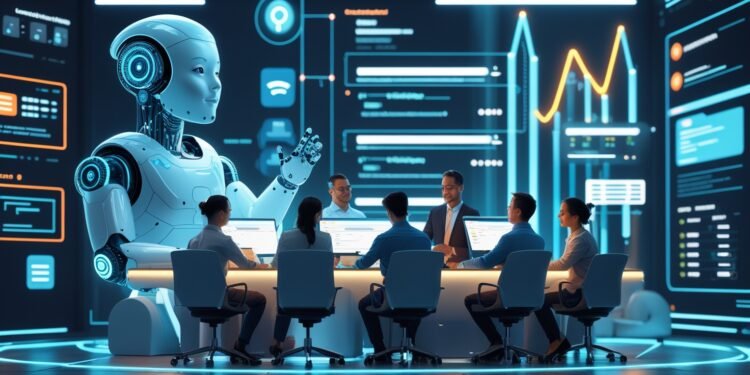AI has already transformed how we write, search, and code—but its next big frontier is hiding in plain sight: the IT service desk. Once viewed as a cost center burdened by ticket queues and frustrated users, IT Service Management (ITSM) is undergoing a radical transformation. And at the center of it all? Large Language Models (LLMs) like OpenAI’s ChatGPT, Anthropic’s Claude, and enterprise-grade AI tools integrated into ServiceNow, Jira Service Management, and more.
We’re now seeing AI in ITSM evolve from a novelty into a non-negotiable capability—shaping the way enterprises handle tickets, incidents, knowledge sharing, and employee support at scale.
From Reactive to Proactive: The New Role of AI in ITSM
Traditional ITSM tools are reactive by nature. Users file a ticket, someone in IT gets to it eventually, and the cycle repeats. But LLMs have introduced a conversational, real-time, and proactive interface between users and IT operations.
LLM-Driven Capabilities:
-
Instant ticket triage: LLMs categorize and route tickets based on intent, urgency, and historical context.
-
Natural language self-service: Employees describe their issue in plain English and get AI-generated answers—or even direct resolutions.
-
Knowledge article summarization and generation: LLMs can write, tag, and update internal knowledge base content automatically.
-
Incident correlation: AI detects patterns across multiple tickets and raises alerts before outages happen.
The result? A faster, smarter, more intuitive IT experience—and a huge reduction in first-line support costs.
ChatOps Meets Service Management
Enter ChatOps for ITSM—where Slack, Microsoft Teams, or even voice assistants become the front line of IT support. LLMs can embed directly into these platforms to handle real-time ticket creation, lookup, and problem resolution.
Picture this:
“Hey IT bot, I can’t connect to the VPN again.”
— Within seconds, the LLM recognizes the issue, checks for known outages, offers step-by-step troubleshooting, and creates a follow-up ticket if needed.
This is the consumerization of IT—bringing the ease of Siri and ChatGPT to enterprise operations.
Predictive Operations and Self-Healing Systems
AI in ITSM isn’t just reactive—it’s increasingly predictive and autonomous.
By analyzing telemetry from endpoints, cloud workloads, and service desk data, LLM-backed systems can:
-
Predict ticket spikes based on software changes or seasonal patterns
-
Detect abnormal behaviors that signal upcoming outages
-
Launch automated remediation (e.g., restarting a service, applying a config change)
This leads to self-healing infrastructure—where the service desk doesn’t just resolve problems, it prevents them before users ever notice.
The Rise of AI-Powered Knowledge Bases
A long-time pain point in ITSM has been knowledge bases—often outdated, hard to search, and rarely used. LLMs are changing that completely.
Smart KB Benefits:
-
Generate knowledge articles directly from resolved tickets
-
Summarize lengthy documentation into user-friendly steps
-
Enable semantic search instead of exact keyword matching
-
Provide context-aware recommendations based on the user’s question
In 2025, the best KBs will be less of a database and more of a living conversation powered by AI.
ITSM Vendors Are Rushing In
The major players are already embedding LLMs at the core of their platforms:
-
ServiceNow: Now Assist uses generative AI for case summaries, chat responses, and KB updates.
-
Atlassian Jira Service Management: Offers AI-driven categorization and smart issue resolution.
-
Freshservice by Freshworks: Launched Freddy AI, an LLM agent for ticket resolution and asset management.
-
BMC Helix: Integrates LLMs to provide predictive insights and user-driven automation.
Meanwhile, startups like Aisera and Moveworks are building AI-first service desk experiences from the ground up.
Governance, Accuracy, and the Trust Problem
With power comes responsibility. Deploying LLMs in ITSM requires safeguards to ensure:
-
Data privacy and compliance (especially with employee conversations)
-
Accuracy and traceability of AI-generated responses
-
Human-in-the-loop workflows for high-impact issues
-
Transparency about what’s generated vs. what’s from a human
Smart organizations are combining AI governance tools, feedback loops, and role-based access controls to build trust into the system from day one.
What CIOs and IT Leaders Should Do Now
If you’re not already exploring LLMs in your ITSM strategy, you’re falling behind. But it’s not about replacing humans—it’s about enhancing them.
Quick Wins to Consider:
-
Deploy an AI agent in your internal help desk or Slack instance
-
Use LLMs to auto-summarize tickets and update KB content
-
Train AI models on internal historical ticket data for better predictions
-
Build a roadmap for GenAI-enhanced employee support tools
LLMs give IT leaders a chance to reposition ITSM from cost center to innovation enabler.
Final Thoughts: Service Management, Reimagined
The future of ITSM isn’t a ticketing portal—it’s a living, conversational layer of intelligence that sits between users and technology. With large language models now capable of understanding intent, context, and urgency, we’re seeing a shift from process management to experience management.
This isn’t just a tool upgrade—it’s a mindset shift.
AI is no longer the future of ITSM. It’s the present. And those who embrace it now will lead the way in building faster, smarter, more human IT experiences.


















